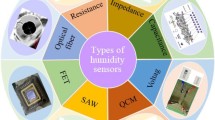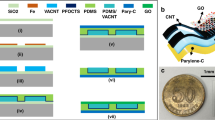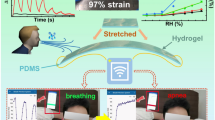Abstract
Humidity monitoring plays a key role in the human–machine interface (HMI) and health-related devices. Current inorganic sensing materials provide a stable and fast method to monitor relative humidity (RH). However, these materials require complicated preparation processes and even toxic reagents. Organic humidity-sensing materials were considered to be biocompatible, but they face slow response time and cannot be used in real-time systems. There is still a great challenge to seek biocompatible humidity-sensing materials with high performance. Micro-nano structures formed by self-assembled peptides have been proven to have good optical, mechanical, semiconductive properties and intrinsic biocompatibility, which can be used for monitoring human health and activities. Herein, we reported an environmentally friendly humidity sensor based on peptide self-assembled micro-nano fibers. This humidity sensor was fabricated by a drop-coating method, in which the peptide fiber served as the humidity-sensing material and the Au electrode was used as a substrate. Self-assembled fiber networks exhibit excellent absorption of water molecules, which result in an extraordinary humidity sensitivity of more than 30,000 as well as ultrafast response (66 ms). To demonstrate the multifunctional possibilities, peptide humidity sensors were applied to respiration monitoring, non-contact switch, and baby diaper wetting monitoring. Our results provide useful strategies for detecting humidity changes in physiological activities based on peptide self-assembled fibers. These results indicated that peptide could be a promising candidate for human–machine interaction and healthcare humidity monitoring.






Similar content being viewed by others
References
Aizen R, Tao K, Rencus-Lazar S, Gazit E (2018) Functional metabolite assemblies-a review. J Nanopart Res 20(5):125
Al-Sehemi AG, Al-Assiri MS, Kalam A, Zafar Q, Azmer MI, Sulaiman K, Ahmad Z (2016) Sensing performance optimization by tuning surface morphology of organic (D-π-A) dye based humidity sensor. Sens Actuat B Chem 231:30–37
Andrade-Filho T, Ferreira FF, Alves WA, Rocha AR (2013) The effects of water molecules on the electronic and structural properties of peptide nanotubes. Phys Chem Chem Phys 15(20):7555
Bahuguna G, Adhikary VS, Sharma RK, Gupta R (2019) Ultrasensitive organic humidity sensor with high specificity for healthcare applications. Electroanal 32(1):76–85
Chen D, Pei Q (2017) Electronic muscles and skins: a review of soft sensors and actuators. Chem Rev 117(17):11239–11268
Cheng Y, Wang J, Qiu Z, Zheng X, Leung NLC, Lam JWY, Tang BZ (2017) Multiscale humidity visualization by environmentally sensitive fluorescent molecular rotors. Adv Mater 29(46):1703900
Chou K, Lee C, Liu B (2016) Effect of microstructure of ZnO nanorod film on humidity sensing. J Am Ceram Soc 99(2):531–535
Deng X, Verdaguer A, Herranz T, Weis C, Bluhm H, Salmeron M (2008) Surface chemistry of Cu in the presence of CO2 and H2O. Langmuir 24(17):9474–9478
Duan Z, Jiang Y, Yan M, Wang S, Yuan Z, Zhao Q, Sun P, Xie G, Du X, Tai H (2019) Facile, flexible, cost-saving, and environment-friendly paper-based humidity sensor for multifunctional applications. ACS Appl Mater Inter 11(24):21840–21849
Fan Z, Sun L, Huang Y, Wang Y, Zhang M (2016) Bioinspired fluorescent dipeptide nanoparticles for targeted cancer cell imaging and real-time monitoring of drug release. Nat Nanotechnol 11(4):388–394
Fei T, Jiang K, Liu S, Zhang T (2014) Humidity sensor based on a cross-linked porous polymer with unexpectedly good properties. RSC Adv 4(41):21429
Jiang K, Fei T, Zhang T (2014a) Humidity sensor using a Li-loaded microporous organic polymer assembled by 1,3,5-trihydroxybenzene and terephthalic aldehyde. RSC Adv 54(4):28451–28455
Jiang K, Fei T, Zhang T (2014b) Humidity sensing properties of LiCl-loaded porous polymers with good stability and rapid response and recovery. Sens Actuat B Chem 199:1–6
Lee J, Heo K, Schulz-Schönhagen K, Lee JH, Desai MS, Jin H, Lee S (2018) Diphenylalanine peptide nanotube energy harvesters. ACS Nano 12(8):8138–8144
Liu C, Han S, Xu H, Wu J, Liu C (2018) Multifunctional highly sensitive multiscale stretchable strain sensor based on a graphene/glycerol-KCl synergistic conductive network. ACS Appl Mater Inter 10(37):31716–31724
Moore AN, Lopez Silva TL, Carrejo NC, Origel Marmolejo CA, Li I, Hartgerink JD (2018) Nanofibrous peptide hydrogel elicits angiogenesis and neurogenesis without drugs, proteins, or cells. Biomaterials 161:154–163
Nguyen V, Jenkins K, Yang R (2015) Epitaxial growth of vertically aligned piezoelectric diphenylalanine peptide microrods with uniform polarization. Nano Energy 17:323–329
Nguyen V, Zhu R, Jenkins K, Yang R (2016) Self-assembly of diphenylalanine peptide with controlled polarization for power generation. Nat Commun 7(1):1–6
Pang Y, Jian J, Tu T, Yang Z, Ling J, Li Y, Wang X, Qiao Y, Tian H, Yang Y, Ren T (2018) Wearable humidity sensor based on porous graphene network for respiration monitoring. Biosens Bioelectron 116:123–129
Reches M, Gazit E (2003) Casting metal nanowires within discrete self-assembled peptide nanotubes. Science 300(5619):625–627
Safaryan S, Slabov V, Kopyl S, Romanyuk K, Bdikin I, Vasilev S, Zelenovskiy P, Shur VY, Uslamin EA, Pidko EA, Vinogradov AV, Kholkin AL (2018) Diphenylalanine-based microribbons for piezoelectric applications via inkjet printing. ACS Appl Mater Inter 10(12):10543–10551
Singh H, Tomer VK, Jena N, Bala I, Sharma N, Nepak D, Sarkar AD, Kailasam K, Pal SK (2017) Truxene based porous, crystalline covalent organic frameworks and it’s applications in humidity sensing. Molecules 49:50
Su C, Chiu H, Chen Y, Yesilmen M, Schulz F, Ketelsen B, Vossmeyer T, Liao Y (2019) Highly responsive PEG/gold nanoparticle thin-film humidity sensor via inkjet printing technology. Langmuir 35(9):3256–3264
Tao K, Makam P, Aizen R, Gazit E (2017) Self-assembling peptide semiconductors. Science 358(6365):m9756
Wang J, Yuan C, Han Y, Wang Y, Liu X, Zhang S, Yan X (2017) Trace Water as prominent factor to induce peptide self-assembly: dynamic evolution and governing interactions in ionic liquids. Small 13(44):1702175
Wang Y, Liu Y, Zou F, Jiang C, Mou C, Wang T (2019) Humidity sensor based on a long-period fiber grating coated with polymer composite film. Sensors (Basel) 19(10):2263
Weng Z, Qin J, Umar AA, Wang J, Zhang X, Wang H, Cui X, Li X, Zheng L, Zhan Y (2019) Lead-free Cs2BiAgBr6 double perovskite-based humidity sensor with superfast recovery time. Adv Funct Mater 29(24):1902234
Wu J, Sun Y, Wu Z, Li X, Wang N, Tao K, Wang G (2019) Carbon nanocoil-based fast-response and flexible humidity sensor for multifunctional applications. ACS Appl Mater Inter 11(4):4242–4251
Yu H, Wang C, Meng F, Liang L, Kashan HS, Adhikari KK, Wang L, Kim E, Kim N (2019) Design and analysis of ultrafast and high-sensitivity microwave transduction humidity sensor based on belt-shaped MoO3 nanomaterial. Sens Actuat B Chem 304:127138
Funding
This work was supported by the National Natural Science Foundation of China ([61925307], [U1613220], [61821005], [61927805], [91748212], and [61903359]), The Instrument Developing Project of the Chinese Academy of Sciences (Grant No. YJKYYQ20180027), and China Postdoctoral Science Foundation (Grant No. 2019M651163).
Author information
Authors and Affiliations
Contributions
HS: data analysis, and writing—original draft. LL, RW, and PY: writing—review and editing. LL and JS: conceptualization of this study, methodology, and funding acquisition.
Corresponding author
Ethics declarations
Conflict of interest
The authors declare that they have no conflict of interest.
Additional information
Publisher's Note
Springer Nature remains neutral with regard to jurisdictional claims in published maps and institutional affiliations.
Supplementary Information
Below is the link to the electronic supplementary material.
Rights and permissions
About this article
Cite this article
Shi, H., Wang, R., Yu, P. et al. Facile environment-friendly peptide-based humidity sensor for multifunctional applications. Appl Nanosci 11, 961–969 (2021). https://doi.org/10.1007/s13204-021-01683-0
Received:
Accepted:
Published:
Issue Date:
DOI: https://doi.org/10.1007/s13204-021-01683-0




